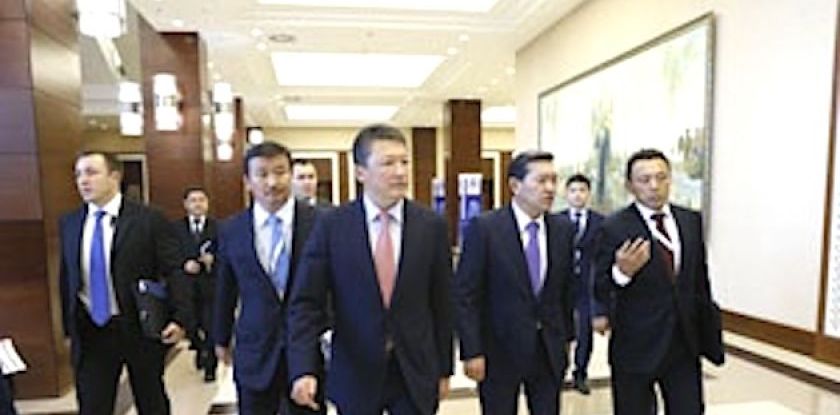How much Akorda spent on the support of the six «chosen» banks in 2017 is well-known. However, only few people are aware in exactly what ways did the Kazakhstan authorities support the «sinking» financial institutes before that. Let us see what the KazMunayGaz’ analysts have to say about that.
In the articles KMG: What Will Happen if Nazarbayev Leaves and KMG: On the Managers’ Compensation Packages, we have started to review the document prepared by the national company’s analysts for the foreign investors. It is called the Base Prospect of the U.S.10,500,000,000 $ Global Medium Term Note Programme. It was published at the beginning of April 2017 by JSC NC KazMunayGaz (a joint-stock company incorporated in the Republic of Kazakhstan) and KazMunaiGaz Finance Sub B.V. (a limited liability company incorporated in the Netherlands unconditionally and irrevocably guaranteed by the JSC NC KazMunayGaz).
We find this document particularly interesting because it allows to look at many topics (for instance, the Kazakhstan banking system crisis) from a different perspective, that of the largest national company.
How much Akorda spent on the support of the six «chosen» banks in 2017 is well-known. However, only few people are aware in exactly what ways did the Kazakhstan authorities support the «sinking» financial institutes before that. In particular, we are talking about placing the temporarily surplus funds of the quasi-government business-structures with the private banks.
The Base Prospect contains the following information on the subject (text in bold — Kazakhstan 2.0).
«For the past several years, the Company has distributed its excess liquidity approximately evenly among international banks (including local branches of international banks) and Kazakhstan banks.
As at 31 December 2016, the Company’s levels of current cash accounts and deposits held with Kazakhstan banks were U.S.3.2 $ billion (compared to U.S.2.5 $ billion as at 31 December 2015 and, U.S.4.7 $ billion as at 31 December 2014), of which U.S.0.5 $ billion (compared to U.S.0.3 $ billion as at 31 December 2015 and U.S.0.9 $ billion as at 31 December 2014) was held with Kazkommertsbank, U.S.2.2 $ billion (compared to U.S.1.7 $ billion as at 31 December 2015 and U.S.1.4 $ billion as at 31 December 2014) was held with Halyk Bank and no cash or deposits (compared to no cash or deposits as at 31 December 2015 and 2014) was held with BTA Bank.
Samruk-Kazyna’s policy is for entities that it controls (including the Company) to limit their cash and cash equivalents (including deposits) in international banks to 10% of the total amount, although there are no legal consequences to a violation of this policy. Depending on the levels of cash maintained by the Company, compliance with this policy could increase the Company’s exposure to the Kazakhstan banking sector. As at 31 December 2016, certain members of the Group, including KMG EP, were not in compliance as a result of the high level of cash deposits maintained by such entities».
Thus, as at 31 December 2016, KazMunayGaz JSC NC held with Halyk Bank and Kazkommertsbank 2.7 $ bln of the 3.2 $ bln placed with the Kazakhstan banks. As at 31 December 2015, it was 2 $ bln out of 2.5 $ bln. As at 31 December 2014, it was 2.2 $ bln out of 4.7 $ bln.
In general, the dynamics of the support increase was as follows: as at 31 December 2014 — 47%, as at 31 December 2015 — 80%, as at 31 December 2016 — 84% of the entire support volume. Note that the share of the two mentioned banks in the total volume of the country’s banking system assets constituted 30%, 38%, and 38%, respectfully.
This discordance shows that, when placing its funds during 2014-2016, KazMunayGaz JSC NC showed an increasingly greater preference for Halyk Bank and Kazkommertsbank. Even though the financial standing of the former was solid whereas the latter was under a great suspicion on the part of the regulator and the market (later, the suspicions turned out to be 100% correct). But, then, both banks ended up in the hands of a single elite group.
To prove the non-randomness the national company’s policies, we will quote yet another paragraph from its Base Prospect that testifies to the KazMunayGaz management’s knowledge of the following, «In the event that the Kazakhstan banking sector encounters difficulties, it could result in a de facto or de jure freezing of all or a portion the Company’s cash, which could have a material adverse effect on the Company’s business, prospects, financial condition, cash flows or results of operations».










George
While government injections have helped the banking sector provision for soured debt -- estimated at as high as 45 percent of total loans by S&P Global Ratings last year -- Kazakh growth remains dependent on natural resources. Oil counts for some 15 percent of gross domestic product, more than half of Kazakhstan's exports and a third of government revenue.